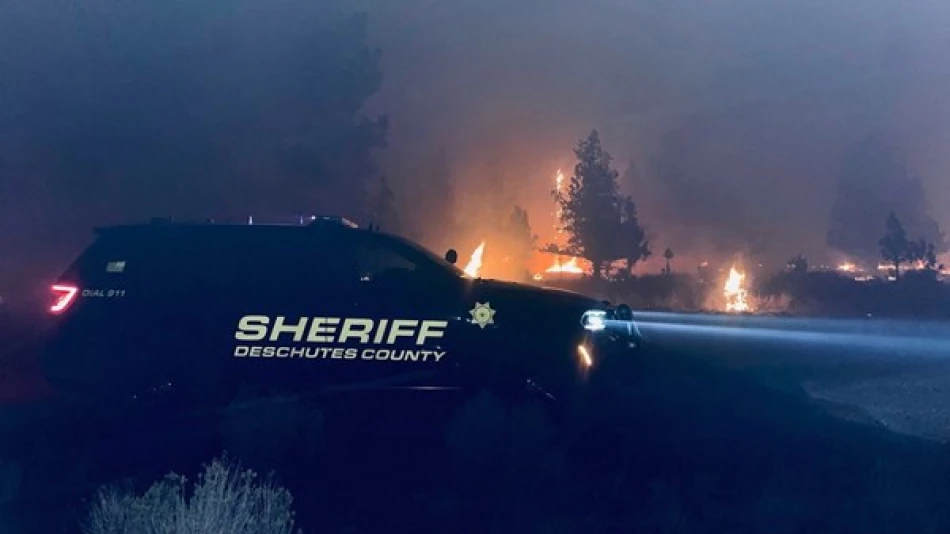
Devastating Wildfire Ravages Homes and Threatens Thousands in Oregon
Oregon Wildfire Destroys Homes as Western US Faces Another Devastating Fire Season
A rapidly spreading wildfire in central Oregon has destroyed 10 buildings including four homes, forcing evacuation orders for 4,000 residences across Oregon and Northern California. The "Flat Fire" incident underscores the growing intensity of wildfire seasons that continue to plague the American West, testing both emergency response capabilities and community resilience in fire-prone regions.
Immediate Damage and Emergency Response
The Flat Fire, spanning 29 square miles (75 square kilometers) across Deschutes and Jefferson counties, has prompted immediate evacuation orders for 1,000 homes, with an additional 3,000 residences under evacuation warnings. Despite the destruction, hundreds of other buildings in Deschutes County survived the blaze as of Sunday evening, highlighting the mixed outcomes typical of wildfire events.
Deschutes County Sheriff Ty Robert acknowledged both the tragedy and the success of firefighting efforts in a Facebook post, stating his department felt "deep sadness for the loss of homes and personal property" while expressing encouragement that "hundreds of homes have been protected thanks to strong firefighting efforts and proactive work by homeowners to reduce fuel around their homes."
The Broader Western Fire Crisis
Climate and Seasonal Patterns
The Oregon fires occur amid hot, dry conditions that have become increasingly common across the Western United States. These weather patterns, combined with accumulated dry vegetation, create ideal conditions for rapid fire spread—a scenario that has become disturbingly routine for Western communities.
The timing aligns with historical fire season peaks, but the intensity and frequency of such events have escalated significantly over the past decade. California and Oregon have experienced some of their most destructive fire seasons on record in recent years, with 2020's fires burning over 4 million acres in California alone.
Community Preparedness and Defense Strategies
The sheriff's comments highlight an important shift in wildfire management philosophy. The mention of homeowners taking "proactive work to reduce fuel around their homes" reflects growing emphasis on defensible space—the practice of creating fire-resistant zones around properties through vegetation management and strategic landscaping.
This approach has proven effective in multiple fire events across the West, where prepared properties often survive while unprepared neighbors face total loss. Communities in fire-prone areas increasingly invest in fire-resistant building materials, evacuation planning, and coordinated neighborhood defense strategies.
Economic and Insurance Implications
Wildfire damage carries significant economic consequences beyond immediate property loss. Insurance markets in Western states face mounting pressure from repeated catastrophic losses, leading to policy cancellations and premium increases in high-risk areas. Some insurers have withdrawn entirely from certain California and Oregon markets.
The broader economic impact extends to tourism, agriculture, and local businesses that suffer from smoke damage, evacuation disruptions, and long-term recovery costs. Communities often require years to fully rebuild and restore economic activity following major fire events.
Looking Forward: Adaptation and Resilience
The Oregon fires represent another data point in the evolving reality of Western wildfire risk. Communities across the region continue adapting through improved building codes, enhanced emergency communication systems, and better coordination between agencies and residents.
Success stories—like the hundreds of homes that survived the Flat Fire—demonstrate that effective preparation and response can limit damage even in severe conditions. However, the underlying risk factors of climate change, drought, and accumulated forest fuels suggest that such events will remain a persistent challenge for Western communities.
The incident serves as a reminder that wildfire preparedness has become a year-round necessity rather than a seasonal concern, requiring sustained investment in both prevention and response capabilities.
 Layla Al Mansoori
Layla Al Mansoori







